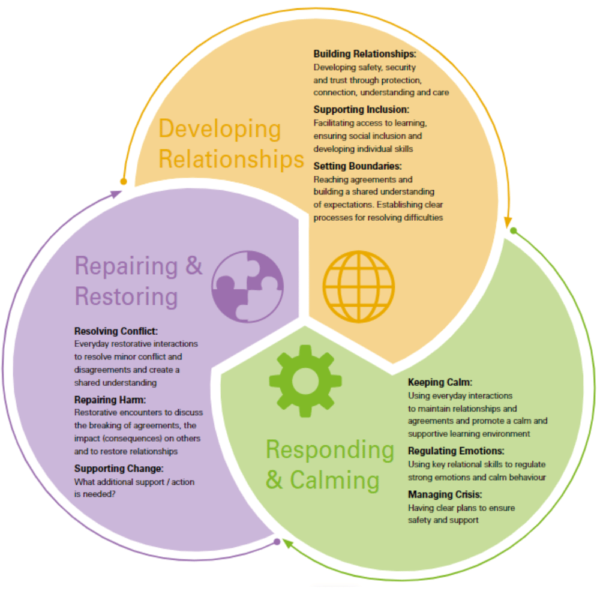Contents
Introduction

The guidance describes a relational approach to teaching and learning which influences whole school ethos and systems as well as everyday teaching practice and targeted support. It seeks to support schools to develop Relational Behaviour Policies where behaviour is seen as the communication of a need and which take into account current research and theory from the fields of attachment and trauma and on effective support for personal development. The guidance was written in response to well documented concerns regarding young people’s mental health and well-being and long standing national trends which show the disproportionate exclusion of children from vulnerable groups. Establishing and maintaining systems and practice in line with Relational Policy will involve whole school approaches and ongoing commitment.
This will include:
- Establishing consistent thinking, understanding and beliefs and values across all school staff, parents/ carers and partner agencies.
- Whole staff training, continual professional development and induction for new staff in relational theory and practice. Ongoing staff support through regular meetings and individual supervision and coaching to support the development and maintenance of skills.
- The consistent implementation of relational practice by all staff which is supported through clear systems and processes as well as active support and modelling by line mangers and senior leaders.
- Systems and provision to support a clear graduated response to supporting children’s needs which is child centred and involves parents and external agencies.
There are three main components to the model, Developing Relationships, Responding and Calming and Repairing and Restoring. For each of these the guidance explores implications for whole school universal support and also targeted support for those most in need.
Developing relationships

Developing Relationships involves Building Relationships, Supporting Inclusion and Setting Boundaries.
In order to be successful at school all children need to build relationships which enable them to feel safe and secure and develop a sense of belonging in school. This is done though providing relational support in the form of Protection, Connection, Understanding and Care.
In order to be fully included some children need additional support to enable them to access learning and to be included in all aspects of school life. It is important to consider whether children’s SEN and wider needs have been recognized and supported.
In order to learn together we need to have a shared understanding of our rights, roles and responsibilities and how these manifest themselves as expectations of behaviour, agreements and rules. Boundaries should be clearly communicated and regularly discussed.
Responding and calming

Responding and Calming involves Keeping Calm, Regulating Emotions and Managing Crisis.
The art and skill of teaching lies in the use of everyday interactions which actively maintain relationships, manage low level disruption and promote a calm, harmonious and supportive learning environment.
Most children will at some point overstep a boundary and will need reminding about agreements and expectations.
We need to develop relational skills that enable us to maintain calm, show understanding, reset agreements and provide clear instruction and guidance around expectations. Supportive action and intervention within the classroom will enable most children to stay within boundaries.
Children who experience strong emotions that lead to harmful or challenging behaviour will need skilful co-regulation to enable them to be calm and develop their capacity for regulation. How we respond in a crisis should be coordinated, clear and communicated to ensure the safety of all students.
Repairing and restoring

Repairing and Restoring involves Resolving Conflict, Repairing Harm and Supporting Change. Sometimes things will go wrong. Even with strong relationships, clear boundaries and good co-regulation there will still be times when conflict emerges or harm is caused.
Applying a restorative framework following conflict or when incidents have taken place can be far more successful in supporting understanding and learning than a punitive approach.
Restorative frameworks need to be underpinned by a strong restorative ethos. Adults need to be skilled and able to use, model and teach good co-operation, communication and emotional literacy skills.
Restorative work involves regular conversations, class meetings, peer mediation, conflict resolution as well as more formal restorative meetings and enquiries.